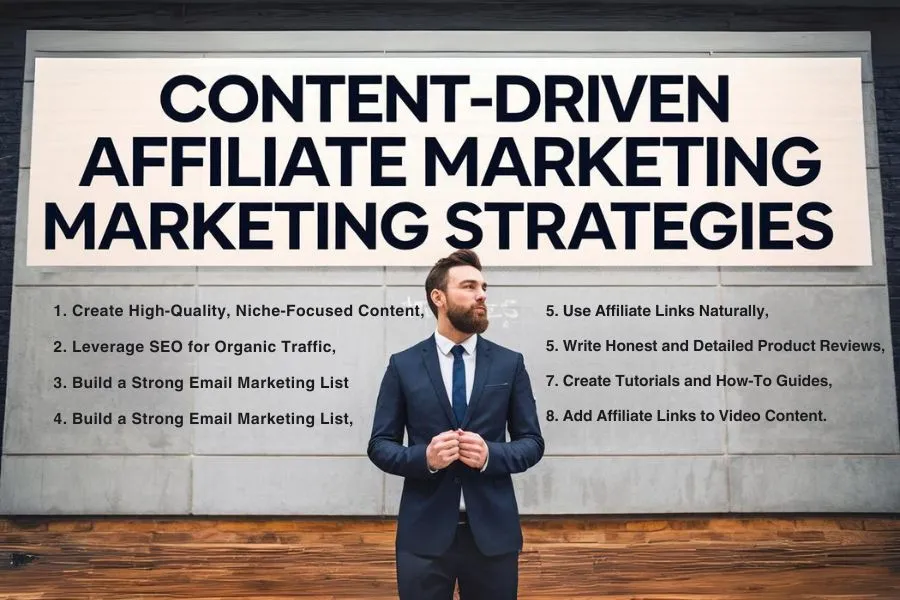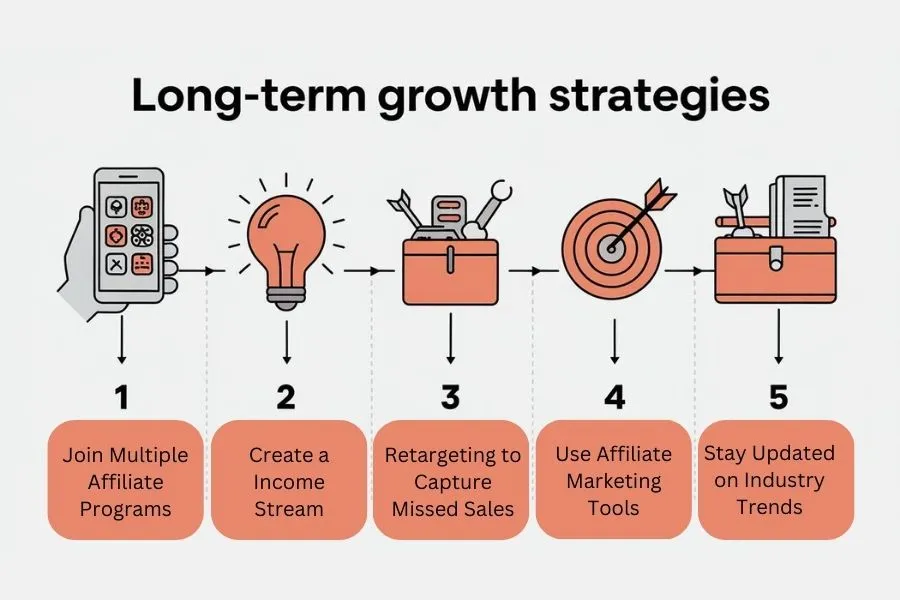Table of Contents
Affiliate marketing is a massive industry with the potential for passive income, but to truly maximize your earnings, you need to adopt effective strategies. Let’s dive into 30 of the best affiliate marketing strategies designed to help you optimize your efforts and see real, tangible results.
Basics of Affiliate Marketing
Before jumping into strategies, it’s important to understand how affiliate marketing works. In this system, three key players are involved:
- The Merchant (the product owner)
- The Affiliate (you, promoting the product)
- The Customer (the one making the purchase)
This triangle is the core of affiliate marketing, and getting all three sides to work smoothly will ensure that you’re on your way to higher earnings.
Top 30 Affiliate Marketing Strategies for Maximum Earnings
Content-Driven Affiliate Marketing Strategies

1. Create High-Quality, Niche-Focused Content
Niche-specific content helps build authority and trust with your audience. Instead of promoting everything, focus on a particular niche that resonates with your audience’s needs.
Example: A blog focused on “sustainable living” could create articles on eco-friendly products, sustainable fashion, and organic food.
2. Leverage SEO for Organic Traffic
Search engine optimization is essential for driving organic traffic. Focus on long-tail keywords that have low competition but high search intent to capture relevant audiences.
Example: Using keywords like “best organic shampoo” and “eco-friendly cleaning products” in your content.
3. Build a Strong Email Marketing List
Email marketing is one of the most effective ways to keep your audience engaged. Offering exclusive content, discounts, or updates through emails can drive affiliate sales.
Example: Offering exclusive discounts or free resources to subscribers. Like Mailchimp
4. Use Affiliate Links Naturally within Blog Posts
Don’t spam your readers with affiliate links. Instead, incorporate them naturally into your content where they make sense and add value.
5. Write Honest and Detailed Product Reviews
Authenticity is key. Detailed product reviews not only help your audience make informed decisions but also increase trust in your recommendations.
Example: A review of a new camera that highlights its pros and cons.
6. Create Tutorials and How-To Guides
Step-by-step tutorials that explain how to use a product or service are incredibly helpful. Include affiliate links to products that can solve the problem you’re discussing.
Example: A video tutorial on using a new software tool with affiliate links to the software.
7. Add Affiliate Links to Video Content
Platforms like YouTube allow you to embed affiliate links in your video descriptions. Create videos that demonstrate the product in action to drive traffic through these links.
Example: Including affiliate links in the description of a YouTube video about a new gadget.
Advanced Traffic and Promotion Strategies
8. Utilize Social Media to Boost Traffic
Don’t overlook the power of social platforms like Instagram, Facebook, and TikTok for promoting your affiliate content. Engage with your audience and direct them to your affiliate links.
Example: Sharing affiliate links on Instagram stories or Facebook groups.
9. Run Paid Ad Campaigns (Google Ads, Facebook Ads)
Paid ads can give your promotions an instant boost. Target specific audiences who are more likely to convert using these platforms’ advanced targeting tools.
Example: Targeting people interested in “fitness equipment” with ads for affiliate products.
10. Optimize for Mobile Users
Ensure that your site and affiliate links are mobile-friendly, as a significant portion of traffic comes from mobile devices today.
Example: Ensuring your website is responsive and easy to navigate on mobile devices.
11. Leverage Pinterest for Affiliate Marketing
Pinterest is a goldmine for driving traffic. Pin valuable content that links back to your affiliate offers, making sure your pins are visually appealing.
Example: Creating visually appealing pins that link to affiliate products.
12. Use Forums and Communities for Promotion
Engage in niche communities like Reddit and Quora. Provide helpful answers and naturally drop affiliate links when relevant.
Example: Answering questions on Reddit and providing helpful advice with affiliate links.
13. Collaborate with Other Bloggers and Influencers
Collaborations can expose your affiliate offers to a wider audience. Team up with bloggers or influencers who align with your niche.
Example: Guest posting on other blogs or participating in joint giveaways.
14. Promote Affiliate Products via Podcasts
Podcasting is a growing medium. Mention affiliate products naturally during your episodes and include links in your show notes.
Example: Mentioning affiliate products during a podcast episode and including links in the show notes.
Conversion Optimization and Analytics
15. Use Data Analytics to Track Performance
Tools like Google Analytics can show you where your traffic is coming from and how your affiliate links are performing. Use analytic data to optimize strategy.
Example: Using Google Analytics to track the performance of affiliate links and optimize your strategy.
16. A/B Test Your Affiliate Links
Testing different placements, colors, or anchor texts of your affiliate links can significantly impact conversions. Always experiment with different variations.
Example: Testing different placements or anchor texts for affiliate links to see what works best.
17. Optimize Your Landing Pages
Create clean, focused landing pages for affiliate products. Too much clutter can confuse visitors and lower conversions.
Example: Creating clear and concise landing pages that focus on a single offer.
18. Improve Page Load Time for Better SEO
A slow-loading site will drive potential buyers away. Use tools like Google PageSpeed Insights for better perform your website’s speed.
Example: Using tools like Google PageSpeed Insights to optimize your website’s speed.
19. Utilize Heatmaps to See User Behavior
Heatmaps show you where visitors are clicking and what areas of your page need improvement. This data can be used to strategically place affiliate links.
Example: Using a heatmap tool to see where visitors are clicking on your website.
20. Ensure Your Site is Secure (SSL)
A secure site builds trust. Users are more likely to purchase from a site that uses HTTPS and displays a padlock symbol.
Example: Using an SSL certificate to ensure your website is secure and trustworthy.
Building Trust and Credibility
21. Be Transparent About Affiliate Links
Always disclose when you’re using affiliate links. Transparency builds your trust with readers, and audiences always appreciate honesty.
Example: Clearly disclosing your affiliate links in your content.
22. Build Strong Relationships with Your Audience
Engage with your readers regularly. Always give response to comments and feedback to build a sense of community.
Example: Engaging with your audience on social media and responding to comments.
23. Only Promote Products You Believe In
Your audience can tell when you’re promoting something you don’t believe in. Stick to products you genuinely recommend.
Example: Focusing on promoting products that you genuinely use and recommend.
24. Respond to Comments and Questions Quickly
Interaction is key. Responding to questions about your affiliate products can lead to higher trust and better conversions.
Example: Promptly answering questions about affiliate products to build trust with your audience.
25. Provide Valuable Free Resources
Giving away valuable resources, like eBooks or courses, can increase traffic and trust, which will, in turn, increase your affiliate sales.
Example: Offering free eBooks or courses to attract and engage your audience.
Scaling and Long-Term Growth Strategies

26. Join Multiple Affiliate Programs
Don’t put all your eggs in one basket. Join different affiliate programs to diversify your income stream.
Example: Joining affiliate programs for various niches and products.
27. Create a Diverse Income Stream
Besides affiliate marketing, consider adding income from digital products, courses, or memberships to secure financial stability.
Example: Selling digital products, offering online courses, or creating memberships.
28. Use Retargeting to Capture Missed Sales
Make sure to retarget visitors who come to your site but didn’t make a purchase. Tools like Google Ads can help bring these visitors back.
Example: Using retargeting ads to reach visitors who didn’t make a purchase.
29. Invest in Affiliate Marketing Tools
Tools like ThirstyAffiliates and Pretty Links can help you manage, cloak, and track your affiliate links for better performance.
Example: Using tools like ThirstyAffiliates or Pretty Links to manage affiliate links.
30. Stay Updated on Industry Trends
The affiliate marketing industry is always evolving. Stay updated on trends and adapt your strategy accordingly to stay competitive.
Example: Following affiliate marketing blogs and attending industry conferences.
Conclusion
Mastering affiliate marketing requires a blend of creativity, strategy, and consistent effort. By implementing these 30 affiliate marketing strategies, you’ll be well on your way to maximizing your earnings and building a sustainable income stream. Remember, the key to success lies in building trust with your audience and continuously optimizing your approach.
FAQs
1. What is the Best Affiliate Marketing Strategy for Beginners?
Focus on creating high-quality content and leveraging SEO for organic traffic.
2. How Can I Increase My Affiliate Marketing Earnings Quickly?
Use a combination of paid ads and email marketing for quicker results.
3. Do I Need a Blog for Affiliate Marketing?
While it helps, you can also use social media, YouTube, and email lists for affiliate marketing.
4. Can I Do Affiliate Marketing Without Spending Money?
Yes! You can start with organic methods like SEO, content marketing, and social media promotion.
5. How Do I Find the Best Affiliate Programs?
Look for reputable networks like Amazon Associates, ShareASale, or CJ Affiliate to find quality programs.

